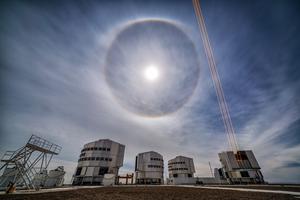Glossary term: Observatory
Description: An observatory is a site or building dedicated to astronomical observations. Optical and infrared observations are usually performed with telescopes placed in domes to protect them during bad weather. Radio telescopes, and some submillimeter telescopes are often placed outside. Modern, ground-based, optical, infrared, or submillimeter astronomical observatories are erected on mountaintops above as much of Earth's atmosphere as possible. These observatories have specialized instruments such as telescopes, cameras, and spectrographs. A high location is less necessary for radio and cosmic ray astronomical observatories. Other parts of the electromagnetic spectrum (gamma, X-ray, ultraviolet radiation, and longer wavelength infrared radiation) can be studied with specific space telescopes that are sometimes also referred to as observatories. Observations for radio telescopes at different sites can be combined together. These multiple sites are often referred to collectively as one observatory.
Related Terms:
- Cosmic Ray
- Electromagnetic Radiation
- Gamma Ray
- Infrared (IR)
- Microwave Radiation
- Radio Waves
- Telescope
- Ultraviolet
- Visible Spectrum
- Cosmic Ray Astronomy
- Submillimeter Astronomy
See this term in other languages
Term and definition status: This term and its definition have been approved by a research astronomer and a teacher
The OAE Multilingual Glossary is a project of the IAU Office of Astronomy for Education (OAE) in collaboration with the IAU Office of Astronomy Outreach (OAO). The terms and definitions were chosen, written and reviewed by a collective effort from the OAE, the OAE Centers and Nodes, the OAE National Astronomy Education Coordinators (NAECs) and other volunteers. You can find a full list of credits here. All glossary terms and their definitions are released under a Creative Commons CC BY-4.0 license and should be credited to "IAU OAE".
If you notice a factual error in this glossary definition then please get in touch.
Related Media
Chilean observatories at home office, by Robert Barsa, Slovakia
Credit: Robert Barsa/IAU OAE
License: CC-BY-4.0 Creative Commons Attribution 4.0 International (CC BY 4.0) icons
ESO's Very Large Telescope (VLT) at Paranal Observatory with a lunar halo
Credit: Juan Carlos Muñoz-Mateos/ESO credit link
License: CC-BY-4.0 Creative Commons Attribution 4.0 International (CC BY 4.0) icons
Keck Telescopes
Credit: NASA/JPL credit link
License: PD Public Domain icons
Hubble Space Telescope over Earth
Credit: NASA/ESA credit link
License: CC-BY-4.0 Creative Commons Attribution 4.0 International (CC BY 4.0) icons
Parkes Radio Telescope
Credit: David McClenaghan/CSIRO credit link
License: CC-BY-3.0 Creative Commons Attribution 3.0 Unported icons













